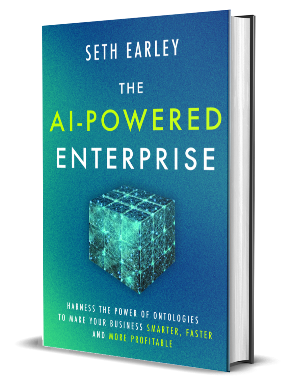Businesses are constantly looking for ways to stay ahead. One of the key technologies driving this change is AI. But how can companies harness AI to its full potential?

Seth Earley's book, "The AI-Powered Enterprise: Harness the Power of Ontologies to Make Your Business Smarter, Faster, and More Profitable," provides a comprehensive roadmap for doing just that. The focus on ontologies is particularly valuable, highlighting an often-overlooked aspect of AI implementation. You can download Earley’s book on the AI-powered enterprise here.
Here are our four takeaways from the book:
Ontologies as a foundation
At the heart of Earley's book is the concept of ontologies. An ontology is a structured framework that represents the language, concepts, and categories used by experts within a company or industry. "It’s what makes the difference between the promise of AI and delivering on that promise." Early notes.
So why is having ontologies important for a successful AI implementation? AI systems need context to function effectively; ontologies supply this context by organizing and structuring data in a way that makes sense to the AI. This is crucial for AI to generate valuable insights and support decision-making processes.
For example, in manufacturing, an ontology can organize the product data, product specifications, service knowledge, and parts. This allows AI to offer more accurate product recommendations, repair diagnosis, and replacement parts by understanding the relationship between customer needs, service requests, and outcomes.
The building of an ontology
Developing an ontology can be a long and arduous process, but it’s one that pays off fast. In the book, Earley provides a few tips to keep in mind when building your business’s ontology.
- Identify core concepts: Identify the main concepts and categories relevant to your business. This involves understanding the key elements that drive your operations and defining them clearly.
- Define relationships: Establish relationships between these concepts. This helps you understand how different pieces of information are connected.
- Standardize terminology: Ensure that terminology is consistent across the organization. This standardization is vital for clear communication and accurate data interpretation.
- Iterate and refine: Ontologies are not static; they need to evolve with your business. Regularly review and update your ontologies to reflect new information and changes in your operations.
Chapter two in the book includes a full guide, complete with tables and real-world examples, on how to build an ontology.
Strategic AI application
The book also provides practical advice on applying AI to solve specific business problems. Through case studies and real-world examples, Earley illustrates how companies have successfully implemented AI to improve their operations.
- Identify objectives: Start with clear business goals. Define what you want to achieve with AI, whether it's improving customer service, increasing operational efficiency, or enhancing product development.
- Leverage case studies and examples: Use real-world examples and case studies to understand how other companies have successfully implemented AI. These examples can provide valuable insights and lessons that can be applied to your own AI projects.
- Develop a strategic plan: Create a strategic plan that outlines how AI will be integrated into business processes. This plan should include a roadmap with clear milestones and deliverables to ensure successful implementation.
- Focus on measurable outcomes: Track the performance of AI initiatives using key performance indicators.
The future of AI in business
In the book's final chapter, Early explores how AI will shape the future of business, predicting significant changes in how companies create and deliver value to customers. He emphasizes the need for businesses to stay ahead of AI trends and adapt continuously to new developments.
As Earley states: “No twenty-first-century executive can succeed without understanding the role of AI in enterprises and how to make this technology work effectively. It’s time to go beyond clouds, big data, and mobile fantasies. It’s time to learn what it takes to power your enterprise with AI, now."
Join us for an exclusive webinar with Seth Earley, where he will discuss the key concepts from his book and share insights on how your business can leverage AI for maximum impact. This is a unique opportunity to learn directly from an expert in the field and get your questions answered. Register now to save your spot.
